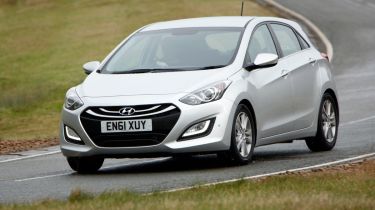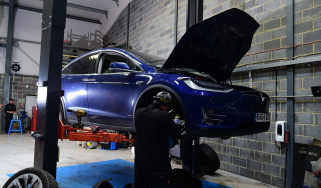Hyundai i30 CRDi
Our verdict on the three efficient diesel engines available in the new Hyundai i30

The Hyundai i30 diesel is a well made family hatchback that offers great value for money, class-leading running costs and safety, excellent refinement and eye-catching styling. The automatic transmission is so smooth that you only need to specify the manual if you absolutely must have the maximum fuel economy and lowest emissions.
We’ve already driven petrol versions of the new Hyundai i30, but now it’s time to try the diesel-engined models, which offer the lowest running costs in the range.
There’s a choice of three diesels, starting with an 89bhp 1.4-litre. The larger 1.6-litre is available with either 108bp or 126bhp. All three are impressively refined: you can’t tell you’re in a diesel when cruising on the motorway. All three get a six-speed gearbox, too. The manual’s shifts are a little notchy, but it’s easy to use, with well-spaced gears, while the automatic is competent and smooth.
Hyundai’s ‘Fluid Motion’ design makes the new i30 look more upmarket, while the range is divided into four trim levels, starting with Classic. This features LED lights and Bluetooth connectivity as standard. Active adds speed-sensitive ‘Flex’ steering, parking sensors and cruise control and is expected to be the biggest seller. The top-of-the-range Style comes with dual-zone climate control and front parking sensors, while the Style Nav version offers all that plus a reversing camera and touchscreen sat-nav.
Used - available now
Whatever trim you choose, the diesel engines offer class-leading efficiency: the manual 1.4-litre Blue Drive in Classic returns a claimed 76.3mpg and emits 97g/km of CO2. In Style Nav, these figures rise slightly to 74.3mpg and 100g/km, but even the most powerful 126bhp diesel emits only 110g/km of CO2.
The i30’s interior is excellent, with good all-round vision, supportive seats and rake and reach adjustable steering. Cabin materials are very high quality for a car in this class, with polished aluminium and gloss black accents, while the centre-console buttons are soft to the touch.
The rear cabin is also impressive: there’s enough head and legroom for six-footers, with space for feet under the front seats. A 60/40-split-folding rear bench means you get 378 litres of luggage space with the seats up and 1,316 litres with them folded. That’s 38 litres more than the old car – partly thanks to the new model being 20mm longer and 10mm wider.
You get plenty of advanced safety kit and driver aids, too: six airbags, electronic stability control, brake assist and hill-start assist are all standard. What’s more, Hyundai expects this car to score a five-star Euro NCAP crash-test rating.
The i30 starts from £14,495 for the Classic, rising to £15,595 for the Active, £16,595 for the Style and £17,595 for the Style Nav.











